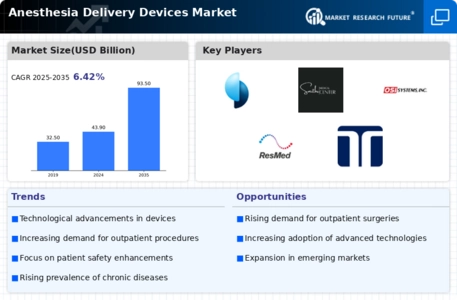Technological Innovations
Technological advancements play a crucial role in shaping the Anesthesia Delivery Devices Market. Innovations such as automated anesthesia delivery systems, real-time monitoring technologies, and enhanced drug delivery mechanisms are transforming the landscape. These advancements not only improve the efficiency of anesthesia administration but also enhance patient safety. For instance, the integration of artificial intelligence in anesthesia devices allows for more precise dosage calculations and monitoring of patient vitals. Market data indicates that the adoption of such technologies is increasing, with a notable rise in the use of smart anesthesia machines. This trend is likely to continue, as healthcare providers seek to leverage technology to improve outcomes and streamline operations.
Rising Surgical Procedures
The increasing number of surgical procedures worldwide is a primary driver for the Anesthesia Delivery Devices Market. As healthcare systems evolve, the demand for surgical interventions rises, leading to a corresponding need for effective anesthesia delivery. According to recent data, the number of surgeries performed annually has been on an upward trajectory, with estimates suggesting that millions of procedures are conducted each year. This surge necessitates advanced anesthesia delivery devices to ensure patient safety and comfort during operations. Furthermore, the growing prevalence of chronic diseases requiring surgical treatment further fuels this demand. Consequently, manufacturers are focusing on developing innovative anesthesia delivery systems to cater to the expanding market, thereby enhancing their market presence and competitiveness.
Growing Geriatric Population
The increasing geriatric population is a significant driver for the Anesthesia Delivery Devices Market. As individuals age, they often require more medical interventions, including surgeries that necessitate anesthesia. The demographic shift towards an older population is prompting healthcare systems to adapt and expand their anesthesia services. Data indicates that the proportion of elderly individuals is rising, leading to a higher demand for specialized anesthesia delivery devices tailored to the needs of older patients. These devices must account for the unique physiological considerations of geriatric patients, thereby driving innovation in the market. Consequently, manufacturers are focusing on developing devices that enhance safety and efficacy for this demographic, further propelling market growth.
Regulatory Support and Standards
Regulatory frameworks and standards are pivotal in shaping the Anesthesia Delivery Devices Market. Governments and health organizations are establishing stringent guidelines to ensure the safety and efficacy of anesthesia devices. This regulatory support fosters innovation and encourages manufacturers to develop high-quality products that meet safety standards. Compliance with these regulations not only enhances product credibility but also boosts consumer confidence in anesthesia delivery systems. Market data suggests that regions with robust regulatory frameworks experience higher adoption rates of advanced anesthesia technologies. As regulatory bodies continue to evolve their standards, the market is likely to witness an influx of innovative devices designed to meet these requirements.
Increasing Awareness of Patient Safety
The growing emphasis on patient safety is significantly influencing the Anesthesia Delivery Devices Market. Healthcare providers are increasingly prioritizing the implementation of safety protocols and advanced technologies to minimize risks associated with anesthesia administration. This heightened awareness has led to the adoption of sophisticated anesthesia delivery systems that incorporate safety features such as alarms, automated drug delivery, and comprehensive monitoring capabilities. Market Research Future indicates that hospitals and surgical centers are investing in these advanced devices to enhance patient care and reduce the incidence of anesthesia-related complications. As a result, the demand for reliable and safe anesthesia delivery devices is expected to rise, driving market growth.
















Leave a Comment